In the ever-evolving world of body art, certain piercings emerge that are defined by their modern, minimalist, and almost architectural beauty. The surface tragus is one such piercing. Sitting flush against the skin in front of the ear, its two glittering ends create a subtle yet striking statement—a sophisticated adornment that is gaining immense popularity in London’s discerning fashion and body art circles for the Autumn/Winter 2025 season.
However, its unique beauty comes with a unique set of challenges. This is not a standard piercing; it is an advanced “surface piercing” with a higher potential for rejection. This is why the skill, knowledge, and honesty of your piercer are not just important—they are everything. We recently had a consultation with a client who came to us asking for a surface tragus London. They had seen it online and loved the look. The first fifteen minutes of our appointment were not spent with a needle, but with a conversation. We explained the nature of surface piercings, the inherent risks of migration and rejection, and thoroughly assessed their anatomy and lifestyle. Impressed by our transparency and commitment to their long-term success, the client felt more confident and informed than ever to proceed.
This is the standard of care we believe every client deserves. This guide is an extension of that honest consultation. It’s a definitive resource for anyone considering this beautiful but complex piercing, covering the procedure, the risks, and why finding the best piercing specialist in London is a non-negotiable first step.
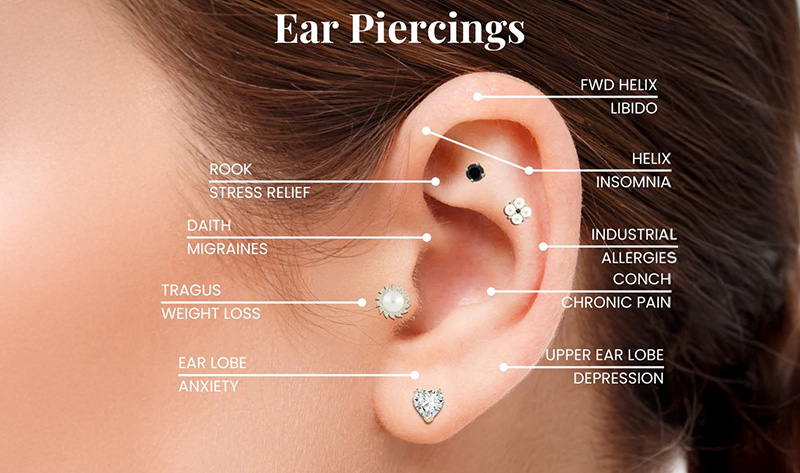
surface tragus
What is a Surface Tragus Piercing? (And What It Isn’t)
Understanding the mechanics of this piercing is crucial. Unlike most ear piercings that go through a piece of cartilage or flesh from one side to the other, a surface tragus is a true surface piercing.
Defining the Placement
A surface tragus piercing does not pass through the tragus cartilage itself. Instead, it is placed on the flat plane of skin in front of the tragus, running vertically. It enters the skin at one point and exits at another, with a single piece of jewellery sitting underneath the skin connecting the two points.
Surface Tragus vs. Standard Tragus
It’s essential to differentiate between these two:
- Standard Tragus: A single piercing that goes directly through the main tragus cartilage, typically exiting on the inside of the ear.
- Surface Tragus: A piercing that only passes under the surface layer of skin in front of the tragus, with both ends of the jewellery visible on the same plane.
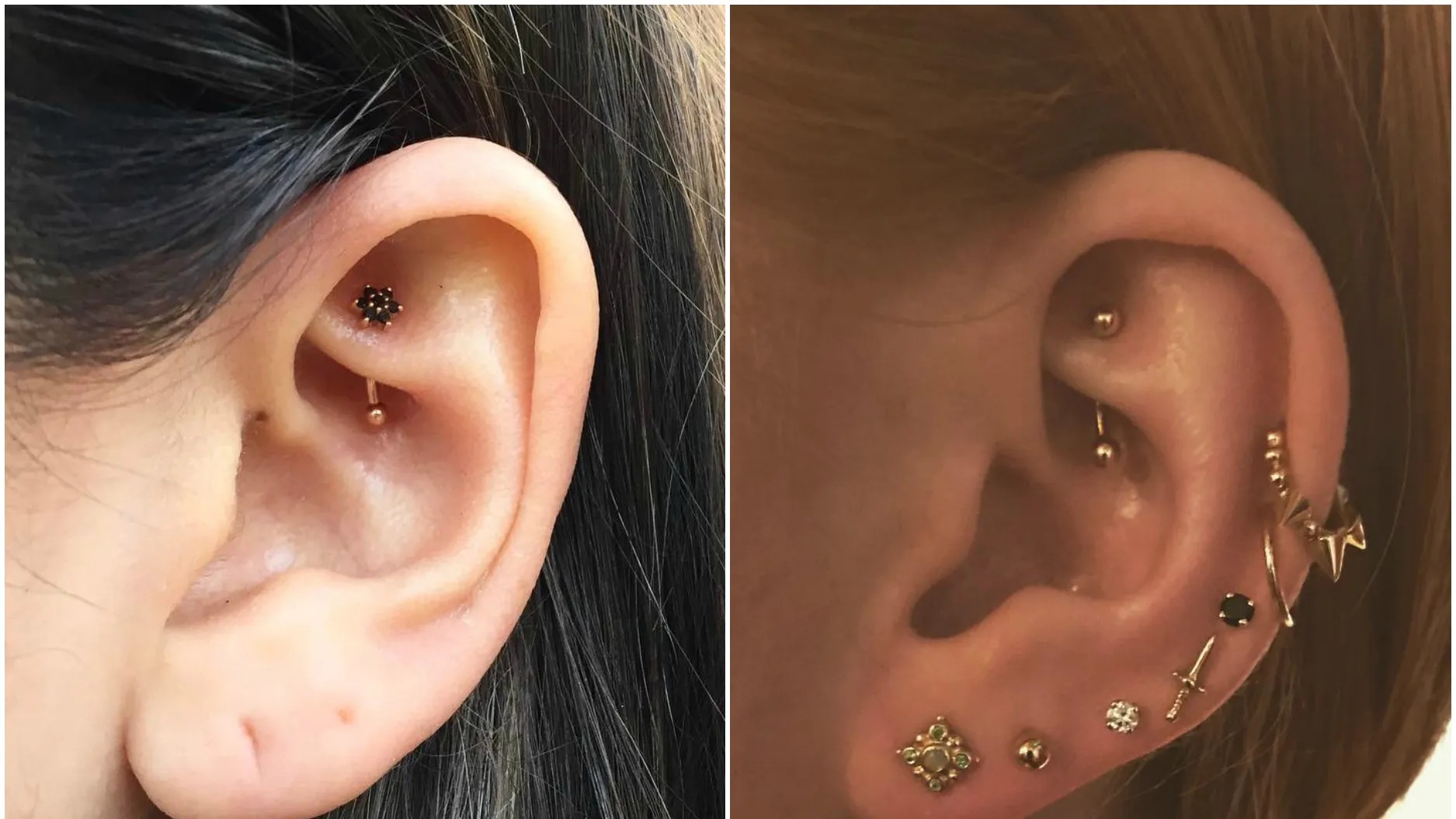
surface tragus
The Jewellery: Why a Surface Bar is Essential
This is a critical point that separates a professional from an amateur. A surface tragus MUST be pierced with a “surface bar.” This is a staple-shaped piece of jewellery with two 90-degree bends and two vertical posts. This shape sits flat under the skin, minimising tension on the entry and exit points.
An inexperienced piercer might attempt this with a curved barbell, which is completely incorrect. A curved barbell creates constant, uneven pressure on the tissue, which will almost certainly lead to irritation, migration, and eventual rejection. At PinkTatPier, we exclusively use implant-grade titanium surface bars for this procedure.
The Elephant in the Room: Understanding Surface Piercing Rejection
We believe in being completely transparent about the risks. The primary challenge with any surface piercing, including the surface tragus, is the risk of rejection.
What is Piercing Rejection?
Rejection is a natural process where the body’s immune system identifies an object as foreign and slowly pushes it out of the skin. It is not an infection. With surface piercings, because the jewellery does not pass through a distinct piece of tissue (like a lobe or helix), there is constant tension on the skin between the two ends. This tension can trigger the body to begin the rejection process.
How the Best Piercing Specialist Minimises Rejection Risk
While the risk of rejection can never be eliminated entirely, it can be dramatically minimised by the skill and technique of an expert piercer. This is our method for giving your surface tragus London piercing the very best chance of success:
- Deep Anatomical Assessment: We will carefully assess the area in front of your tragus. We need to ensure there is enough pliable tissue, away from the strong movements of the jaw muscles, to support the piercing long-term.
- Precise Marking & Depth: The channel for the surface bar must be created at the perfect depth. Too shallow, and it will reject quickly. Too deep, and it can become embedded and cause severe irritation. This requires a master’s touch.
- Using the Correct Jewellery: We use an implant-grade titanium surface bar that is perfectly sized to your unique anatomy. The right size is crucial for minimising tension.
- Lifestyle Consultation: We will discuss your daily habits. Do you wear glasses? How do you apply skincare or makeup? Which side do you sleep on? All these factors can impact the long-term health of a surface piercing.
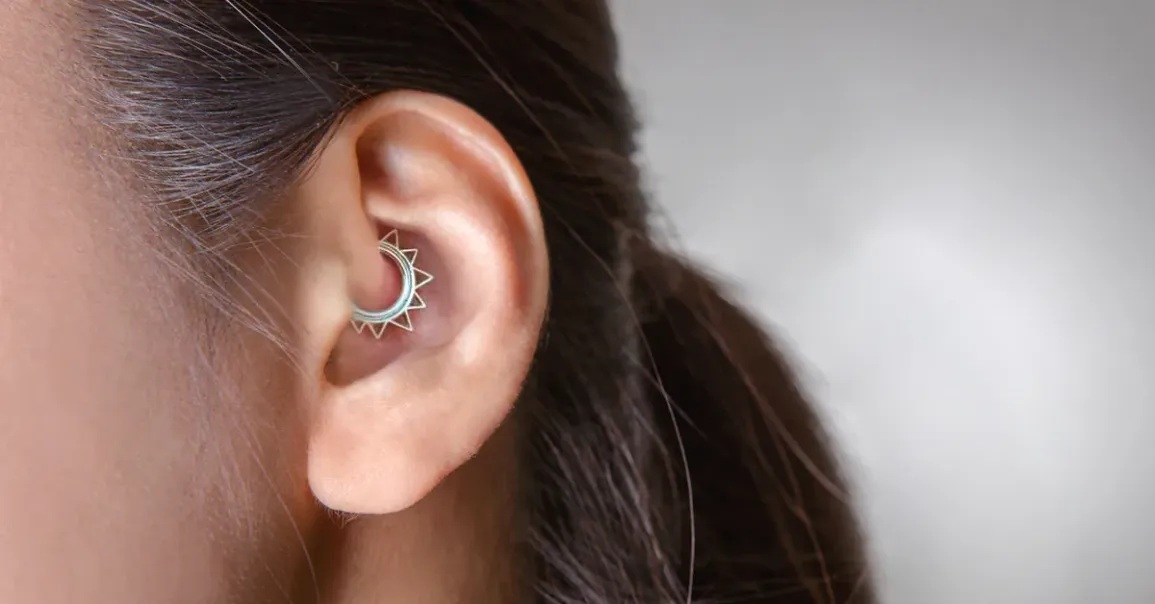
surface tragus
The Procedure & Healing Journey: A Guide to Patience
A surface tragus is a long-term healing project. Understanding the timeline and aftercare requirements is essential.
The Piercing Process: A Specialist at Work
The procedure itself is quick and precise. Your specialist will meticulously mark the placement. The piercing is then performed using a sterile, single-use needle to create a clean channel for the surface bar. The jewellery is then carefully inserted and secured.
The Healing Timeline: What to Expect
Healing a surface piercing is different from a standard piercing. The area is delicate and prone to snags. The table below outlines what you can expect.
Table: Surface Tragus Healing & Aftercare Schedule
| Timescale | What to Expect | Key Aftercare Actions |
| Month 1-2 | Swelling, bruising, and tenderness are common and can be more pronounced than with other piercings. | Clean GENTLY twice daily with sterile saline; DO NOT touch or move the jewellery; avoid all skincare, makeup, and hair products on the area. |
| Month 3-6 | The piercing will begin to stabilize, but the tissue underneath is still very fragile and forming. | Continue gentle cleaning; be hyper-aware of snagging on clothing, hair, glasses, or towels. This is the most common time for irritation to occur. |
| Month 6-12+ | The piercing may appear healed, but the internal channel is still maturing and strengthening. | This is a long-term commitment. Regular check-ups with your piercer are highly recommended to monitor its health. |
| Signs of Rejection | The skin between the two ends becomes red, thin, or flaky; more of the bar becomes visible over time; the piercing holes appear to be getting larger. | Contact us immediately at the first sign of potential rejection. Early intervention can sometimes save the piercing. |
Finding the Best Piercing Specialist in London for Your Surface Tragus
When seeking an advanced piercing like a surface tragus London, your choice of piercer is the single most important factor for success. Here’s what you must look for:
- A Portfolio of HEALED Surface Piercings: Any piercer can show a picture of a fresh piercing. Ask to see photos of surface tragus piercings that are 1+ years old. This is proof of their skill.
- Exclusive Use of Surface Bars: If they even mention using a curved barbell, walk away immediately.
- An In-Depth, Honest Consultation: A true specialist will explain the risks of rejection before they agree to do the piercing. They should assess your anatomy and be willing to say “no” if you are not a suitable candidate.
- A Professional Studio Environment: The studio must be impeccably clean, and the piercer must use single-use needles and autoclave sterilisation.
At PinkTatPier, we proudly meet and exceed all these criteria.
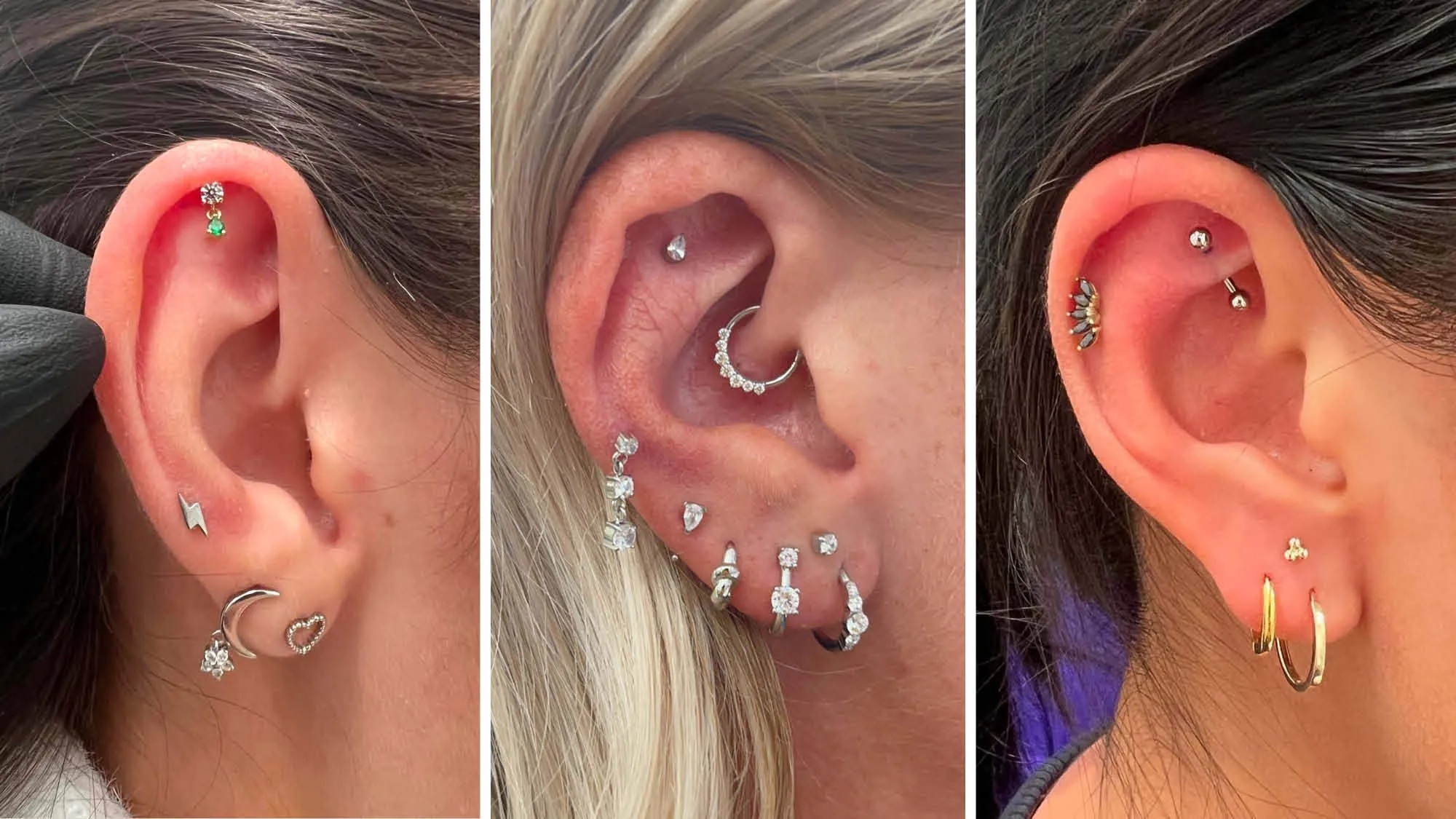
surface tragus
Frequently Asked Questions (FAQ)
1. How long does a surface tragus piercing typically last?
This varies greatly from person to person. A perfectly placed surface tragus on ideal anatomy can last for many years, effectively becoming permanent. However, due to their nature, they are always considered long-term temporary piercings, as a snag or change in the body can trigger rejection at any time.
2. Does the rejection process hurt?
No, rejection is typically a painless process. You will notice the visual signs—the skin thinning and more of the bar showing—long before you feel any discomfort. This is why regular self-assessment is key.
3. Will a rejected surface tragus leave a bad scar?
If the jewellery is removed as soon as the first signs of rejection appear, the scarring will be minimal, often just two small dots that will fade over time. If left to reject completely, it can leave a more noticeable linear scar. This is why early removal is so important.
Conclusion: A Piercing That Demands Expertise
The surface tragus is a high-impact, uniquely modern piercing that requires the highest level of technical skill. Its success is a direct reflection of the piercer’s expertise. This is not a piercing for apprentices or high-street shops; it is a procedure for a master piercer who understands the delicate balance between anatomy, technique, and jewellery. By choosing a true specialist, you are not just paying for a piercing; you are investing in the best possible chance for a beautiful, long-lasting result.
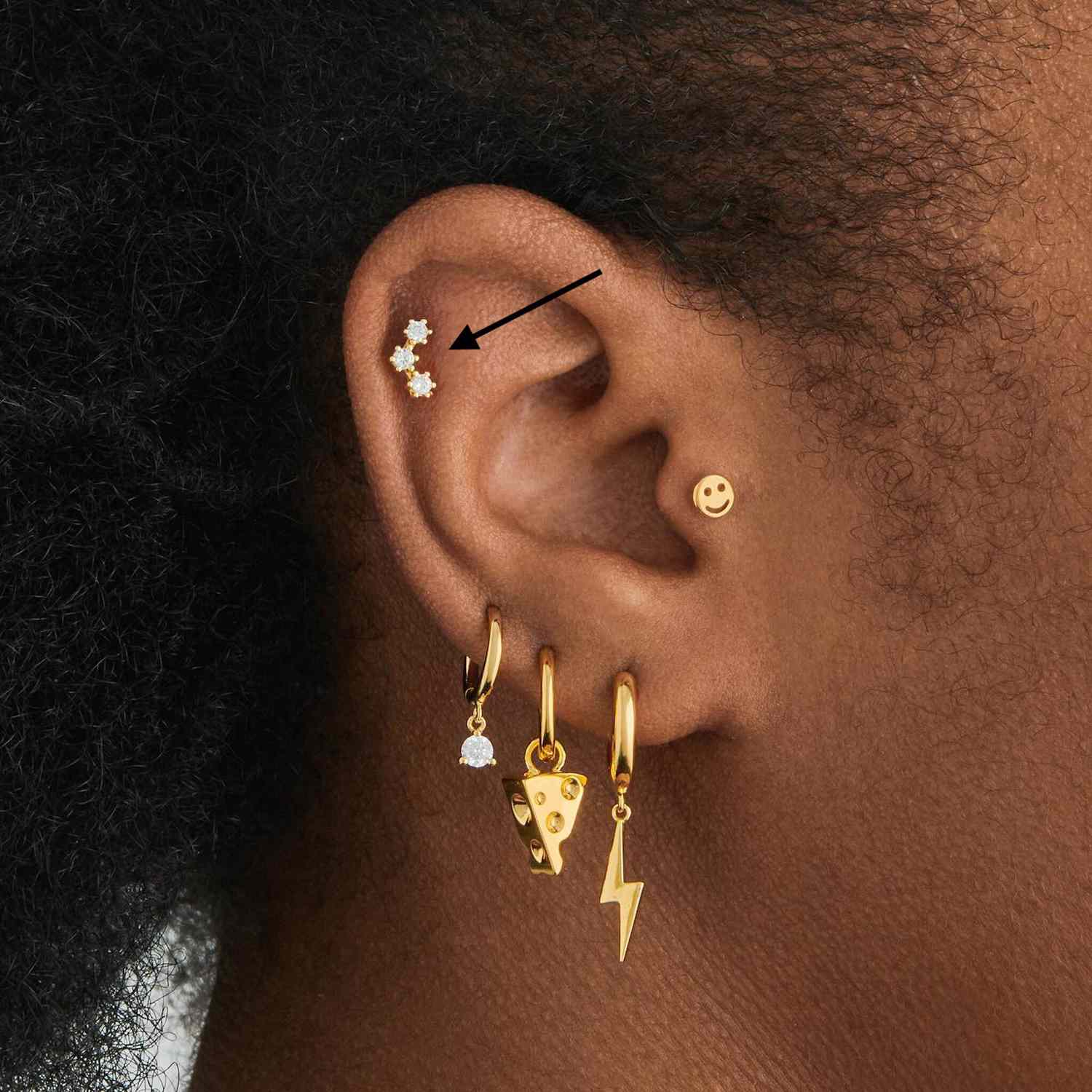
surface tragus
Your Next Step: Book a Consultation with a Specialist
Don’t risk your style or your skin on anything less than the best. If you are looking for the best piercing specialist for a safe surface tragus London, your journey starts with an expert consultation.
We invite you to book your appointment online with the specialists at PinkTatPier. We will assess your anatomy, discuss your vision, and provide an honest, expert opinion on whether this beautiful piercing is the right choice for you.

